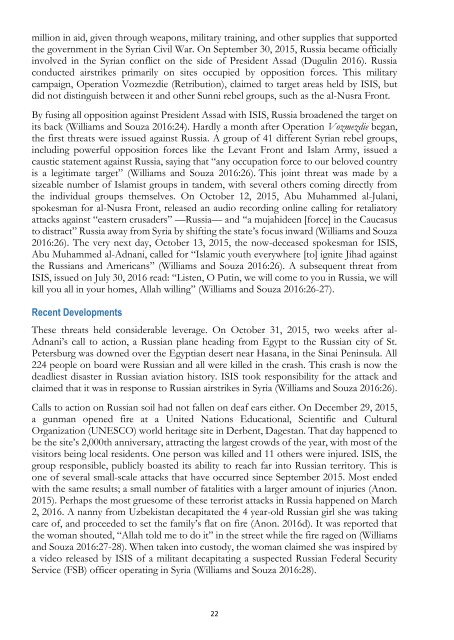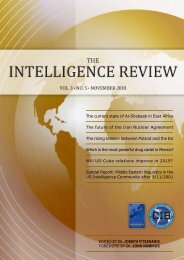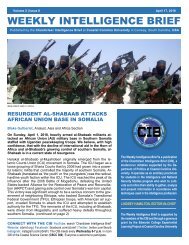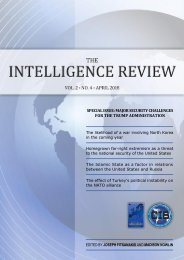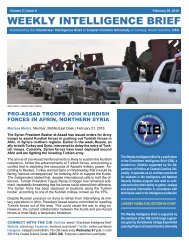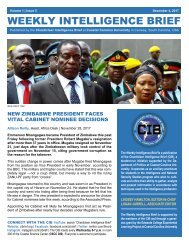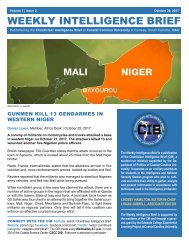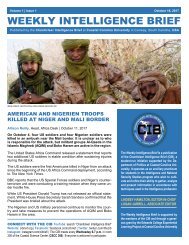The Intelligence Review | volume 1 | issue 2 |
This volume is the product of a collaboration between the European Intelligence Academy (EIA) and the Chanticleer Intelligence Brief (CIB), a student-run initiative supported by the Department of Politics at Coastal Carolina University in Conway, South Carolina, United States. Eleven CIB analysts tackle some of the most pressing and timely questions confronting intelligence observers today. Topics include the gun control debate in the United States, Russia’s involvement in the Syrian Civil War, the future of Kurdish nationalism, and the internal Palestinian dispute between Hamas and Fatah. Papers in this volume also examine the current state of Islamist extremism, and extrapolate on its future prospects in the Middle East, West Africa, the Lake Chad region, as well as in Southeast and Central Asia. CIB analysts propose carefully crafted and informed forecasts that outline future developments in some of the world's most unpredictable hot spots.
This volume is the product of a collaboration between the European Intelligence Academy (EIA) and the Chanticleer Intelligence Brief (CIB), a student-run initiative supported by the Department of Politics at Coastal Carolina University in Conway, South Carolina, United States. Eleven CIB analysts tackle some of the most pressing and timely questions confronting intelligence observers today. Topics include the gun control debate in the United States, Russia’s involvement in the Syrian Civil War, the future of Kurdish nationalism, and the internal Palestinian dispute between Hamas and Fatah. Papers in this volume also examine the current state of Islamist extremism, and extrapolate on its future prospects in the Middle East, West Africa, the Lake Chad region, as well as in Southeast and Central Asia. CIB analysts propose carefully crafted and informed forecasts that outline future developments in some of the world's most unpredictable hot spots.
- No tags were found...
You also want an ePaper? Increase the reach of your titles
YUMPU automatically turns print PDFs into web optimized ePapers that Google loves.
million in aid, given through weapons, military training, and other supplies that supported<br />
the government in the Syrian Civil War. On September 30, 2015, Russia became officially<br />
involved in the Syrian conflict on the side of President Assad (Dugulin 2016). Russia<br />
conducted airstrikes primarily on sites occupied by opposition forces. This military<br />
campaign, Operation Vozmezdie (Retribution), claimed to target areas held by ISIS, but<br />
did not distinguish between it and other Sunni rebel groups, such as the al-Nusra Front.<br />
By fusing all opposition against President Assad with ISIS, Russia broadened the target on<br />
its back (Williams and Souza 2016:24). Hardly a month after Operation Vozmezdie began,<br />
the first threats were <strong>issue</strong>d against Russia. A group of 41 different Syrian rebel groups,<br />
including powerful opposition forces like the Levant Front and Islam Army, <strong>issue</strong>d a<br />
caustic statement against Russia, saying that “any occupation force to our beloved country<br />
is a legitimate target” (Williams and Souza 2016:26). This joint threat was made by a<br />
sizeable number of Islamist groups in tandem, with several others coming directly from<br />
the individual groups themselves. On October 12, 2015, Abu Muhammed al-Julani,<br />
spokesman for al-Nusra Front, released an audio recording online calling for retaliatory<br />
attacks against “eastern crusaders” —Russia— and “a mujahideen [force] in the Caucasus<br />
to distract” Russia away from Syria by shifting the state’s focus inward (Williams and Souza<br />
2016:26). <strong>The</strong> very next day, October 13, 2015, the now-deceased spokesman for ISIS,<br />
Abu Muhammed al-Adnani, called for “Islamic youth everywhere [to] ignite Jihad against<br />
the Russians and Americans” (Williams and Souza 2016:26). A subsequent threat from<br />
ISIS, <strong>issue</strong>d on July 30, 2016 read: “Listen, O Putin, we will come to you in Russia, we will<br />
kill you all in your homes, Allah willing” (Williams and Souza 2016:26-27).<br />
Recent Developments<br />
<strong>The</strong>se threats held considerable leverage. On October 31, 2015, two weeks after al-<br />
Adnani’s call to action, a Russian plane heading from Egypt to the Russian city of St.<br />
Petersburg was downed over the Egyptian desert near Hasana, in the Sinai Peninsula. All<br />
224 people on board were Russian and all were killed in the crash. This crash is now the<br />
deadliest disaster in Russian aviation history. ISIS took responsibility for the attack and<br />
claimed that it was in response to Russian airstrikes in Syria (Williams and Souza 2016:26).<br />
Calls to action on Russian soil had not fallen on deaf ears either. On December 29, 2015,<br />
a gunman opened fire at a United Nations Educational, Scientific and Cultural<br />
Organization (UNESCO) world heritage site in Derbent, Dagestan. That day happened to<br />
be the site’s 2,000th anniversary, attracting the largest crowds of the year, with most of the<br />
visitors being local residents. One person was killed and 11 others were injured. ISIS, the<br />
group responsible, publicly boasted its ability to reach far into Russian territory. This is<br />
one of several small-scale attacks that have occurred since September 2015. Most ended<br />
with the same results; a small number of fatalities with a larger amount of injuries (Anon.<br />
2015). Perhaps the most gruesome of these terrorist attacks in Russia happened on March<br />
2, 2016. A nanny from Uzbekistan decapitated the 4 year-old Russian girl she was taking<br />
care of, and proceeded to set the family’s flat on fire (Anon. 2016d). It was reported that<br />
the woman shouted, “Allah told me to do it” in the street while the fire raged on (Williams<br />
and Souza 2016:27-28). When taken into custody, the woman claimed she was inspired by<br />
a video released by ISIS of a militant decapitating a suspected Russian Federal Security<br />
Service (FSB) officer operating in Syria (Williams and Souza 2016:28).<br />
22


